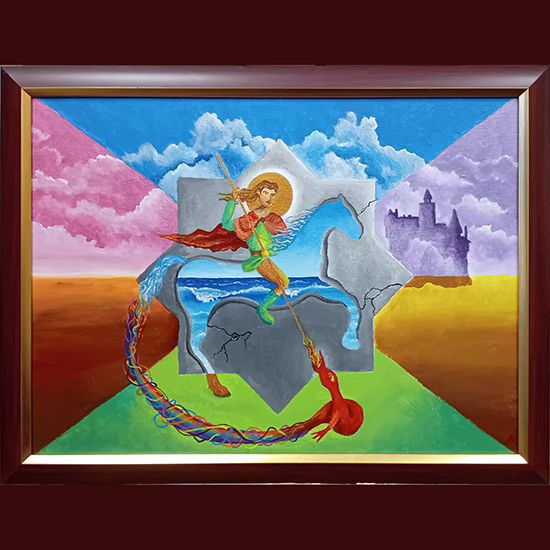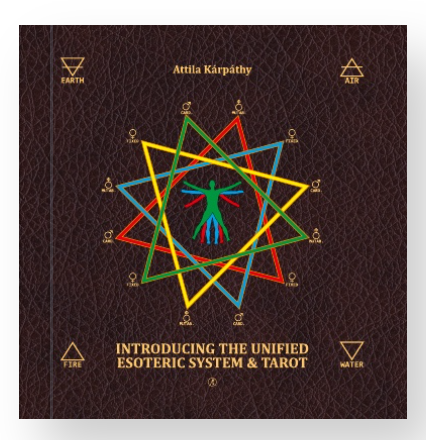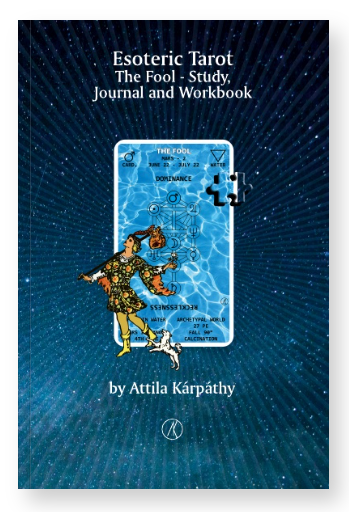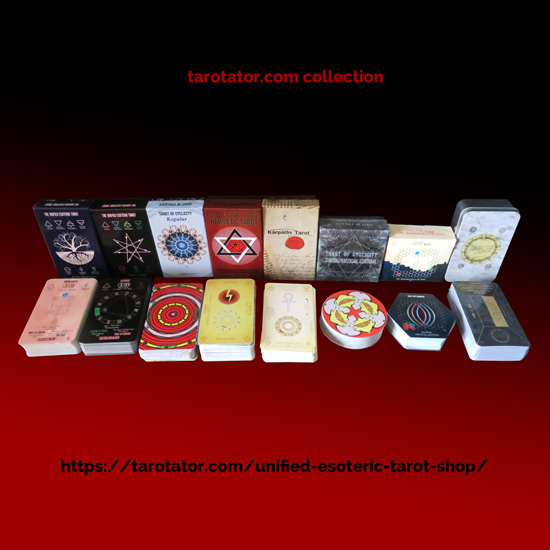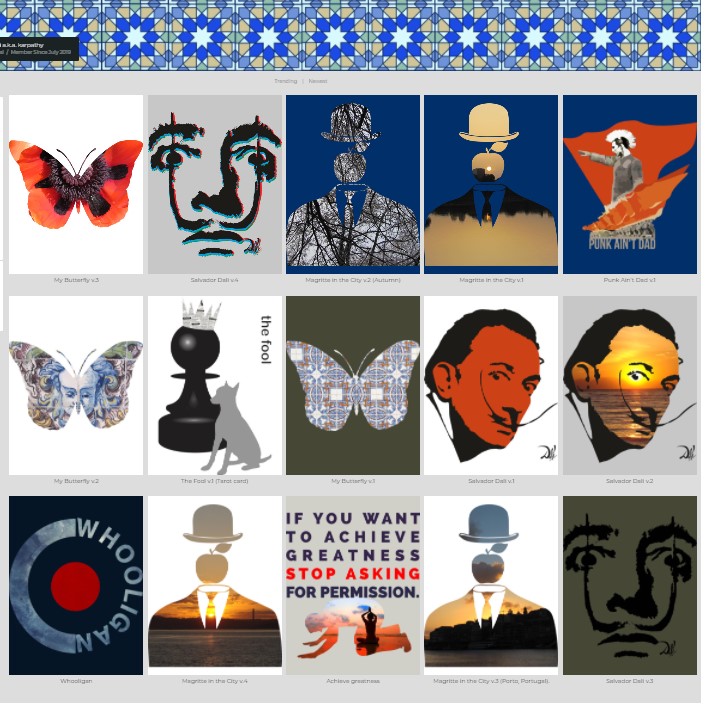The Dragon Slayer (Saint George II)
Acrylic colours on canvas.
20×30 cm (7.87x 11.81 inch)
Bucharest, September, 2024.
Private collection.
My second instalment of Saint George slaying the dragon.
The primary inspiration for this painting was the Equestrian Portrait of Carmen Bordiu-Franco by Salvador Dali, painted in 1974. I recycled that image and rendered it into another naïve flavoured icon.
For personal reasons, I also kept the invocation of the Bran Castle in the background from my previous painting.
The current work emphasises more visible parallels between the Strength card and the Tiamat story. However, the roles are inverted. Just like in the Strength Tarot card, Tiamat is slaying the dragon. It is a statement that goes back to the story’s origins and the part of history that has been erased and forgotten.
The dragon also embodies desire. Slaying the dragons symbolises our struggle to overcome instincts and emotions and become rational and spiritual.
The cyclic union of the horse and the dragon, combined by their tails, signifies the perpetual nature of the struggle. There is no winner or loser, and it is a continuous cycle.
Gurdjieff associated the horse with our emotional centre. As a result, the horse is blue and filled with water. The rider tries to control her emotions. The image of the sea (or ocean) also gives a sense of eternity and constant motion.
It is a new kind of dragon. Our modern world has its particularities and challenges. Once again, history is altered and rewritten to fit current trends and distorted perceptions.
More words and images at BEHANCE.
Naïve art is usually defined as visual art created by a person who lacks the formal education and training that a professional artist undergoes.
Naïve art is recognised and often imitated for its childlike simplicity and frankness.
The characteristics of naïve art have an awkward relationship to the formal qualities of painting, especially not respecting the rules of the perspective.
The oldest surviving Christian paintings are from the site at Megiddo and date to around the year 70.
Until the adoption of Christianity by Constantine, Christian art derived its style and much of its iconography from popular Roman art.
During the development of early Christian art in the Byzantine Empire, a more abstract aesthetic replaced the naturalism previously established in Hellenistic art. This new style was hieratic, meaning its primary purpose was to convey religious meaning rather than accurately render objects and people. Realistic perspective, proportions, light and colour were ignored in favour of geometric simplification of forms, reverse perspective and standardised conventions to portray individuals and events.
An icon is a religious work of art, most commonly a painting, in the cultures of the Eastern Orthodox, Oriental Orthodox, and Catholic churches.
Icons are mostly painted on wood panels with egg tempera.
Eastern Orthodox tradition holds that the production of Christian images dates back to the very early days of Christianity and has been a continuous tradition since then. Modern academic art history considers that, while images may have existed earlier, the tradition can only be traced back to the 3rd century. The images that survive from Early Christian art differ significantly from later ones.
Icons have a candid touch of naïve art.
Although I don’t have any formal education and training in arts, I’ve been painting since my very early days. However, I do not consider myself an artist; I only express myself in different ways and by various means.
Painting an icon was quite challenging.
I tried to combine the traditional cannons of icons with a touch of naïve art.
I chose Saint George because the theme reminded me of Don Quixote, and underneath is a more challenging ancient story.
Saint George was an early Christian martyr who became an ideal of martial valour and selflessness during the Middle Ages. He is the patron saint of England and Georgia and is venerated as one of the 14 Auxiliary Saints, also known as the Holy Helpers.
Nothing of George’s life or deeds can be established, but tradition holds that he was a Roman soldier and was tortured and decapitated under Diocletian’s persecution of Christians in 303.
Legends about him as a warrior-saint, dating from the 6th century, became popular and increasingly extravagant. Jacob de Voragine’s “Legenda aurea” (1265–66; Golden Legend) repeats the story of his rescuing a Libyan king’s daughter from a dragon and then slaying the monster.
Saint George’s slaying of the dragon may be a Christian version of the legend of Perseus, who was said to have rescued Andromeda from a sea monster.
Therefore, most likely, we can trace back the myth of the “dragon slayer” to the Babylonian epic of creation, the Enûma Elish, in which Tiamat, the primordial goddess of the sea, is slain by the storm-god Marduk.
There are two parts to the Tiamat mythos. In the first, she is a creator goddess, through a sacred marriage between different waters, peacefully creating the cosmos through successive generations. In the second Chaoskampf, Tiamat is considered the monstrous embodiment of primordial chaos.
The change of optics occurred during the power shift from matriarchy to patriarchy. As a result, the creator goddess has been changed into the monstrous embodiment of primordial chaos, and a new saviour male god emerged.
A similar change of perception can be observed when the Babylonian goddess Astarte turns into the demon Astaroth.
The Drachenkampf mytheme, the chief god in the role of the hero slaying a sea serpent, is widespread both in the ancient Near East and in Indo-European mythology. Examples include Lotan and Hadad, Leviathan and Yahweh, Tiamat and Marduk, Illuyanka and Tarhunt, and Yammu and Baal in the Baal Cycle.
In Nordic mythology, Jörmungandr was a sea serpent or worm so long that it encircled the entire world, Midgard.Sea serpents also appear frequently in later Scandinavian folklore, particularly in that of Norway, such as an account that in 1028 AD, Saint Olaf killed a sea serpent in Valldal in Norway, throwing its body onto the mountain Syltefjellet.
In antiquity, dragons were envisioned as giant serpentine monsters, with the image of a dragon with two or four legs and wings developing during the Middle Ages.
Although many cultures deeply fear the dragon and other serpent-like creatures, Chinese mythology has a very different perspective. They believe the dragon is responsible for many benevolent gifts, such as good rains that bring good harvests – and perhaps even life itself.
A dragon is any form of serpent that has a fearsome nature. This is indicated by the word ‘drakon,’ derived from the English word ‘dragon’. ‘Drakon’ means ‘large serpent’ or ‘sea serpent.’ Most dragons are described as being evil.
The saint’s veneration of George dates to the fifth or fourth century. The addition of the dragon legend dates to the eleventh century.
One last thing: the scene depicted by Saint George’s slaying of the dragon resembles what is shown in the Tarot card called Strength.
The main difference is that the character taming the lion is a woman.
The Strength card represents an ancient, unaltered archetype conceived before the Christian era.
Although the first physically known Tarot deck might have been the Visconti-Sforza Tarot produced around 1451 in Northern Italy, the origin of the Tarot remains unknown. The blueprints for the deck created in Italy also have ancient and unknown origins.
The Tarot deck is an instrument to preserve and transmit (esoteric) knowledge unaltered.
The Strength card symbolises strength and hidden resistance. Even if the world has changed and Tiamat, from the once benevolent mother of all, has been transformed into a sea monster and eventually slain by Marduk, she survives silently and resists.
It is not something “they” want you to know, yet the esoteric (hidden) information is still there.
#attilakarpathy #art #painting #icon #esoteric #esotericart

